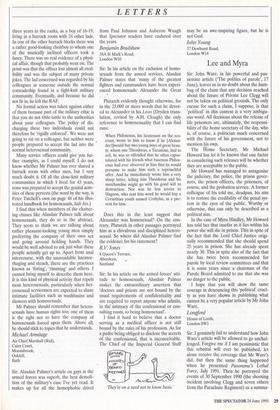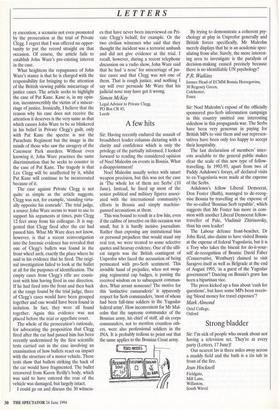Sir: I genuinely fail to understand how John Ware's article
will be allowed to go unchal- lenged. Forgive me if I am pessimistic that this rebuttal will ever be published, let alone receive the coverage that Mr Ware's did, but then the same thing happened when he presented Panorama's Lethal Force, July 1991. Then he portrayed the events of 30 September 1990 (the shooting incident involving Clegg and seven others from the Parachute Regiment) as a summa- ry execution, a scenario not even promoted by the prosecution at the trial of Private Clegg. I regret that I was offered no oppor- tunity to put the record straight on that occasion. Of course, the article fails to establish John Ware's pre-existing interest in the case.
What heightens the repugnance of John Ware's stance is that he is charged with the responsibility for bringing to the attention of the British viewing public miscarriage of justice cases. The article seeks to highlight the case of Pat Kane. Kane is, in my opin- ion, incontrovertibly the victim of a miscar- riage of justice. Ironically, I believe that the reason why his case does not receive the attention it deserves is the very same as that which causes John Ware to be so blinkered in his belief in Private Clegg's guilt, only with Pat Kane the spectre is not the Parachute Regiment but the image in the minds of those who saw the savagery of the Casement Park murders. Without even knowing it, John Ware practises the same discrimination, that he seeks to counter in the case of Pat Kane. The tragedy is that Lee Clegg will be unaffected by it, whilst Pat Kane will continue to be incarcerated because of it.
The case against Private Clegg is not quite as simple as the article suggests. Clegg was not, for example, 'standing virtu- ally opposite his comrade'. The trial judge, a source John Ware seems to want to use to support his arguments at times, puts Clegg 12 feet away from his colleague. It is sug- gested that Clegg fired after the car had passed him. What Mr Ware does not know, however, is that a recent reinvestigation into the forensic evidence has revealed that one of Clegg's bullets was found in the front wheel arch, exactly the place where he said in his evidence that he fired. The origi- nal investigation failed to look at the bullet at all for the purposes of identification. The empty cases from Clegg's rifle are consis- tent with him having fired in one direction. If he had fired into the front and then back at the range found by the trial judge, three of Clegg's cases would have been grouped together and one would have been found in isolation. In fact, they were all found together. Again this evidence was not placed before the trial or appellate court.
The whole of the prosecution's rationale, for advocating the proposition that Clegg fired after the car had passed him has been recently undermined by the first scientific tests carried out in the case involving an examination of how bullets react on impact with the structure of a motor vehicle. These tests show that bullets striking the back of the car would have fragmented. The bullet recovered from Karen Reilly's body, which was said to have entered the rear of the vehicle was damaged, but largely intact.
I could go on and discuss the 30 witness- es that have never been interviewed on Pri- vate Clegg's behalf, for example. Or the two civilian witnesses who said that they thought the incident was a terrorist ambush and did not give evidence at the trial. I recall, however, during a recent telephone discussion on a radio show, John Ware said that he had 'a nose' for miscarriage of jus- tice cases and that Clegg was not one of them. That is rough justice, and nothing I say will ever persuade Mr Ware that his judicial nose may have got it wrong.
Simon McKay
Legal Advisor to Private Clegg, PO Box CR 45, Leeds



























































 Previous page
Previous page